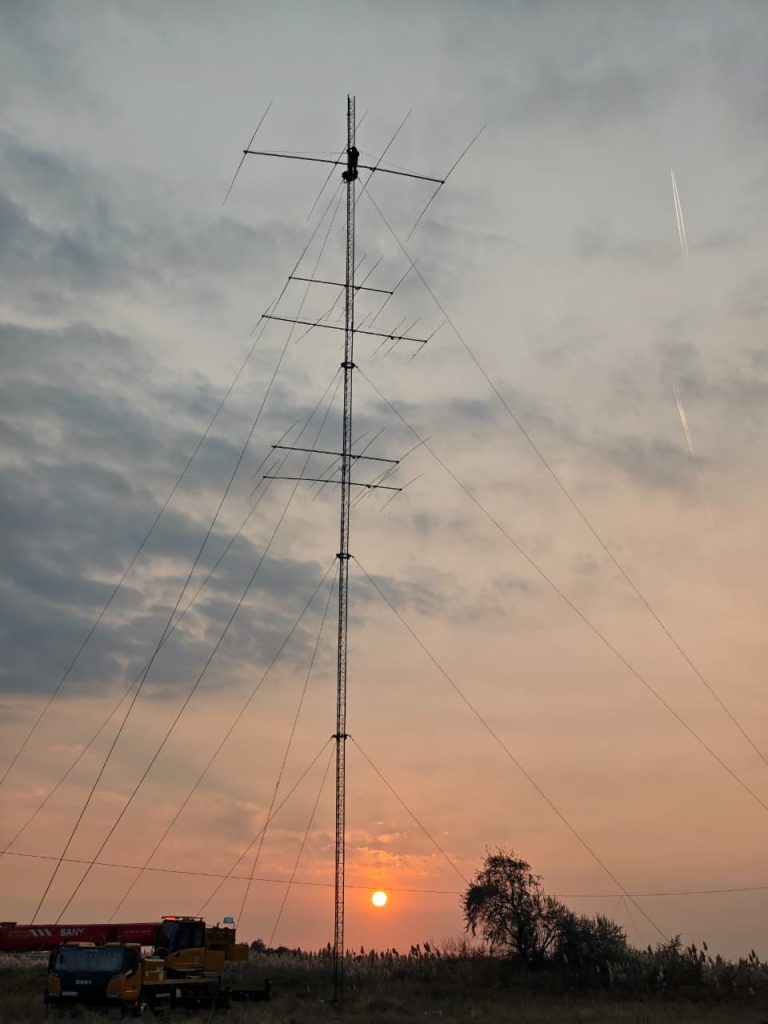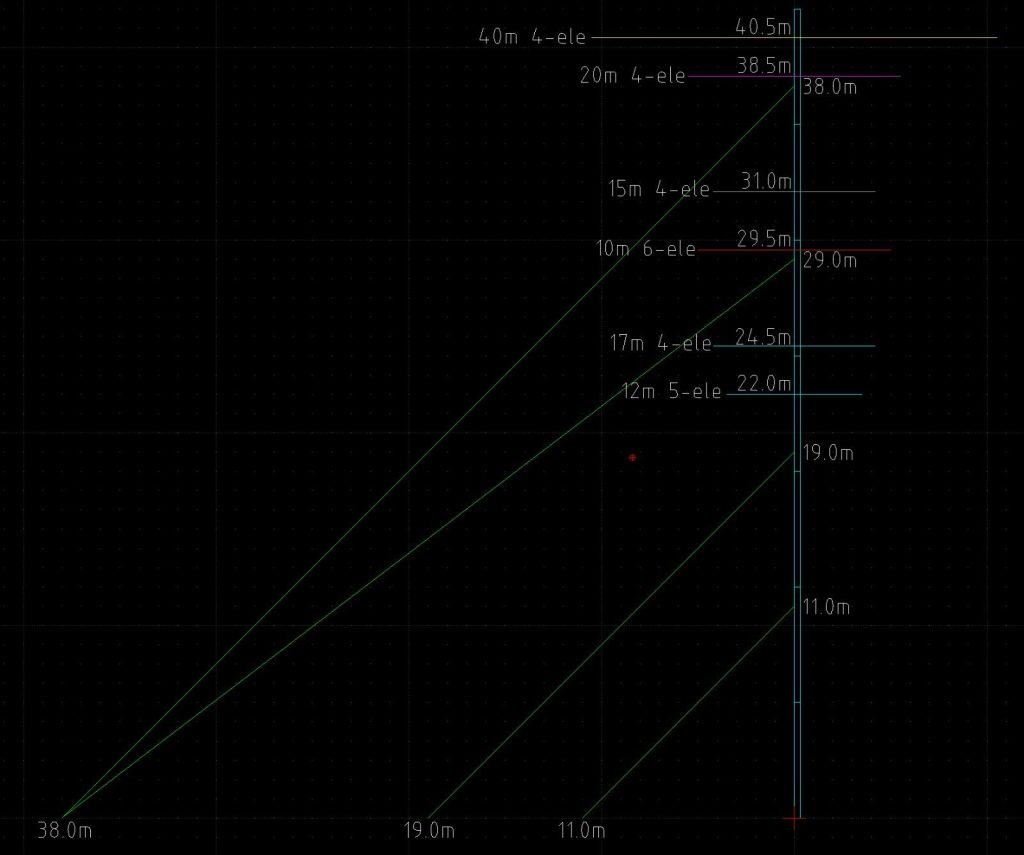A 42-meter rotating tower and its dwellers 🙂
Pre-history
It is a story of a 42-meter rotating tower v2.0. Version 1.0 was a 30-meter tower at that time, and its story is described here.
Update 01.Nov.2025 - in short
- I am still trying to gather information on whether the higher-installed Yagis do really show a better result. Surely, the theory says they do. However, the theory is a theory, and practice is a practice
Current feeling rather than the exact measurements and proven facts – based on occasional comparison and, once again, feeling:
- The 20-meter 4-ele OWA Yagi at the 19-meter height with about 40-meter LMR400 feeder showed the same or, often, better results than its twin sister installed on a 39-meter height with about 100-meter LMR400 cable. Nearly always and clearly, a better result is observed at distances of 3000-5000 km (as expected). However, the lack of a clear benefit on the 10,000-30,000 km paths for the higher-installed Yagi remains a mystery…
- The 15-meter 4-ele OWA Yagi with about 90-meter LMR400 cable installed on 29.5 meters, wins about 1S level to the twin sister at 21 meters … – I first thought … but after even more thorough testing short path and long path to 3D2AG – nope, no notable difference – it is all inside the fluctations between the measurements. We played FT8 with multiple switches back and forth between different antennas. We tested SP and LP. The same story – there is no clear winner. They perform very much the same
- The same or even larger win for the 6-ele OWA 10-meter Yagis: 31m vs. 10m – 31m clearly wins – which is even more surprising, taking into account no apparent benefit for the higher-installed 20-meter Yagi and a substantially higher loss in a 100-meter cable as compared to a 20-meter cable for the lower-installed Yagi … Again, a few days later, we tested with 3D2AG on SP and LP and the conclusion isn’t conclusive 🙂 It looked like the SP – not the LP – with 31m height was winning with a notable few dBs. But I am not sure anymore …
- I need to check more and compare more, but either the older 20-meter Yagi on 19 meters was exceptionally good, somehow. Or the new one isn’t as good for whatever reason. Or, most likely, not so dramatic a gain is eaten by an extra couple of dBs of the cable loss. And a couple of dBs, in practice, is very difficult to spot, because the QSB during even a short QSO may be a few S levels. So, the 2-dB difference is very theoretical, both in terms of gain and losses. Of course, in larger numbers and longer usage, the statistics will take effect, and the +2dB will continue to gain more. However, if you want to switch between identical antennas and compare them quickly, it is not straightforward at all. I did use SSB and FT8 for the comparison. Neither is showing a clear winner when the difference is small
- When the difference is approaching an S-level or more, it is a different picture, and it is pleasantly surprising to see the signal clearly rising from the abyss, when you switch between the antennas to the more performing one
I didn’t plan this before, but now I am starting to think of placing a not-yet-designed shorted 2-element 80-meter Yagi instead of the 20-meter OWA Yagi at the 39-meter mark, i.e., the top of the 42-meter tower will be occupied by about the same-swing antennas:
- A 4-ele full-size 40-meter OWA Yagi – at 1λ-height
- And a shortened 2-ele 80-meter Yagi at 0.5λ-height
Maybe … The QRN from the poorly made LED lamps, converters for solar panels, and similar sources is still about S8 on 80 meters and blocking the noise from the back, which south in my case, would give me a much nicer SNR from Europe and Americas SP and even Australia/New Zealand LP. I have nearly given up on the 150 to 220 degrees range, where Almaty (or sources of noise) lie. The difference is clearly 3S levels or more, depending on the Yagi and its front/back ratio, which is an amazing quality to observe in practice
A current summary:
- 1λ-installed antennas already perform well enough for any DXing, and bringing them higher for the sake of gain, a lower radiation angle, is somehow not confirmed by practice. I am baffled. But that is the current state. Let’s see… Maybe there are some strange mistakes… Perhaps the expectations were too high… I’m not sure. But I haven’t sensed any practical benefit in 2-3λ over 1λ-installed antennas. The costs, on the other hand, can be very high because a 30-meter tower is a far more complex, heavier, larger, and costlier thing than a basic, feather-like 10-meter toy-tower
The installation day - 19.Oct.2025
The plan for the installation day was simple:
- Not to kill anyone 🙂
- Not to break anybody or anything 🙂
- Remove the remnants of the previous 40-meter 4-ele Yagi that was completely smashed by the wind over the course of several months; it has been hanging on the top of the tower
- Put the tower down
- Add 2x6m=12m of sections, thus increasing the height from 30m to 42m
- Raise the tower again
- Install 5 OWA Yagis built over the course of 3-4 weeks prior to that
How it was in pictures
Everything that was initiated and resulted in the tower, its height, and its antennas revolves around the take-off angles. At least, that is what the theory says:
And the whole fun of the entire exercise is to see whether the theory meets the practice and how exactly. The devil, as we know, in detail.
The theory meeting the capabilities resulted in a plan:




